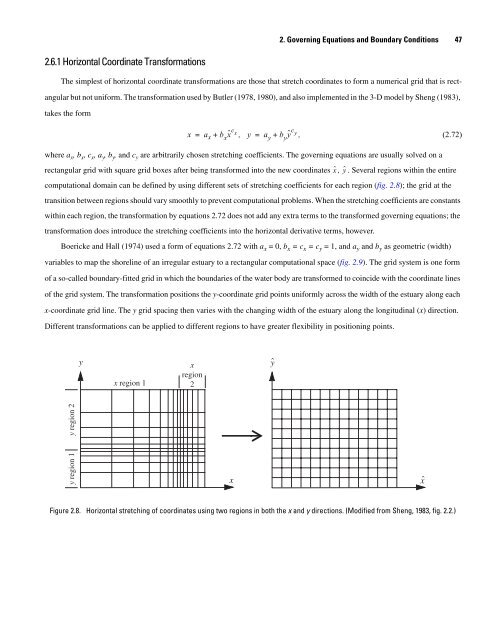A Semi-Implicit, Three-Dimensional Model for Estuarine ... - USGS
A Semi-Implicit, Three-Dimensional Model for Estuarine ... - USGS
A Semi-Implicit, Three-Dimensional Model for Estuarine ... - USGS
You also want an ePaper? Increase the reach of your titles
YUMPU automatically turns print PDFs into web optimized ePapers that Google loves.
2.6.1 Horizontal Coordinate Trans<strong>for</strong>mations<br />
2. Governing Equations and Boundary Conditions 47<br />
The simplest of horizontal coordinate trans<strong>for</strong>mations are those that stretch coordinates to <strong>for</strong>m a numerical grid that is rect-<br />
angular but not uni<strong>for</strong>m. The trans<strong>for</strong>mation used by Butler (1978, 1980), and also implemented in the 3-D model by Sheng (1983),<br />
takes the <strong>for</strong>m<br />
x axbxxˆ c = + x , y aybyyˆ c = + y , (2.72)<br />
where a x, b x, c x, a y, b y, and c y are arbitrarily chosen stretching coefficients. The governing equations are usually solved on a<br />
rectangular grid with square grid boxes after being trans<strong>for</strong>med into the new coordinates xˆ , yˆ . Several regions within the entire<br />
computational domain can be defined by using different sets of stretching coefficients <strong>for</strong> each region (fig. 2.8); the grid at the<br />
transition between regions should vary smoothly to prevent computational problems. When the stretching coefficients are constants<br />
within each region, the trans<strong>for</strong>mation by equations 2.72 does not add any extra terms to the trans<strong>for</strong>med governing equations; the<br />
trans<strong>for</strong>mation does introduce the stretching coefficients into the horizontal derivative terms, however.<br />
Boericke and Hall (1974) used a <strong>for</strong>m of equations 2.72 with a x = 0, b x = c x = c y = 1, and a y and b y as geometric (width)<br />
variables to map the shoreline of an irregular estuary to a rectangular computational space (fig. 2.9). The grid system is one <strong>for</strong>m<br />
of a so-called boundary-fitted grid in which the boundaries of the water body are trans<strong>for</strong>med to coincide with the coordinate lines<br />
of the grid system. The trans<strong>for</strong>mation positions the y-coordinate grid points uni<strong>for</strong>mly across the width of the estuary along each<br />
x-coordinate grid line. The y grid spacing then varies with the changing width of the estuary along the longitudinal (x) direction.<br />
Different trans<strong>for</strong>mations can be applied to different regions to have greater flexibility in positioning points.<br />
y region 2<br />
y region 1<br />
y<br />
x region 1<br />
x<br />
region<br />
2<br />
x<br />
Figure 2.8. Horizontal stretching of coordinates using two regions in both the x and y directions. (Modified from Sheng, 1983, fig. 2.2.)<br />
yˆ<br />
xˆ

















